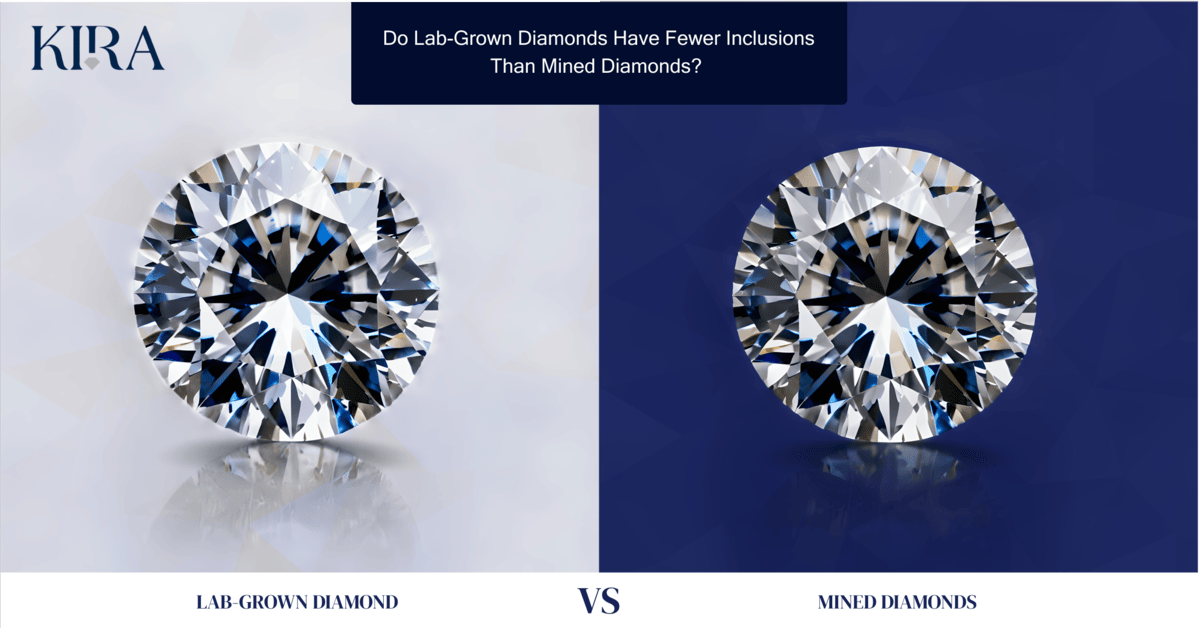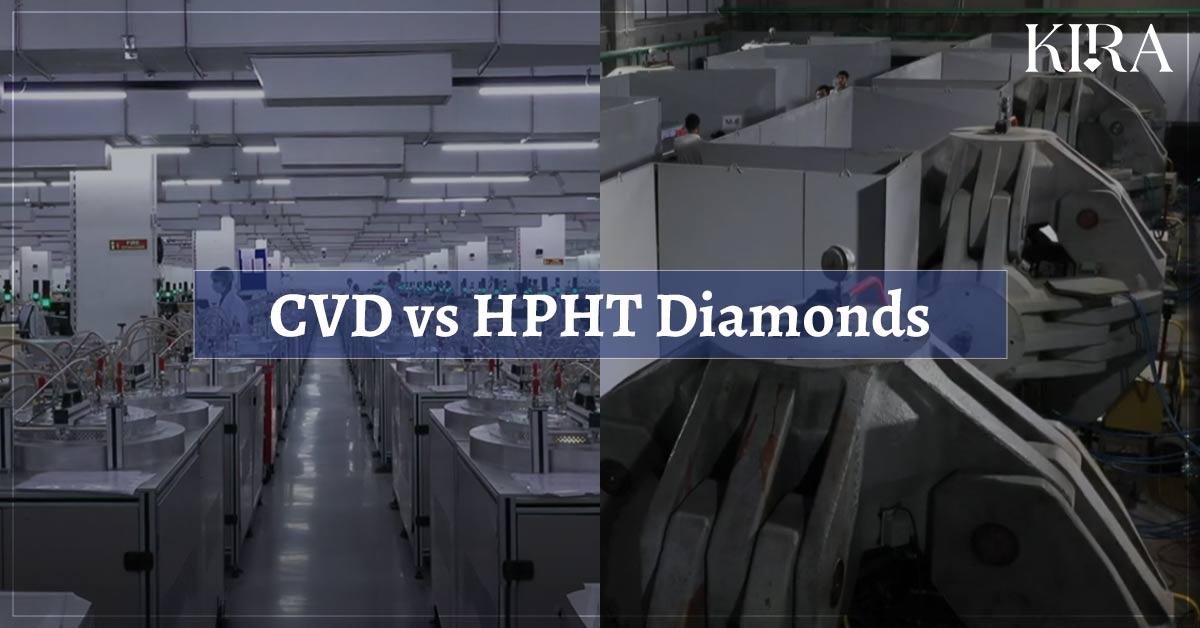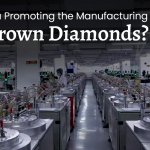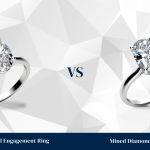Do Lab-Grown Diamonds Have Fewer Inclusions Than Mined Diamonds?

When selecting a diamond, one of the most important factors to consider is clarity. Clarity refers to the absence of internal flaws, known as inclusions, which form during the diamond’s creation process.
But how do these inclusions differ between mined diamonds and lab-grown diamonds? And do lab-grown diamonds really have fewer inclusions? As lab-grown diamonds rise in popularity, especially for their ethical and environmental benefits, clarity becomes a significant deciding factor for many buyers.
What Are Inclusions in Diamonds?
Inclusions are imperfections within a diamond, formed during its growth. These internal flaws can vary widely, appearing as tiny crystals, clouds, or even small fractures. They are a result of the immense pressure and heat that diamonds undergo during their formation. Inclusions essentially tell the story of a diamond’s creation, acting as a fingerprint of the intense natural or artificial conditions it has experienced.
The more inclusions a diamond has, the lower its clarity grade. Clarity is one of the “Four Cs” used to assess a diamond’s overall quality, alongside cut, colour, and carat weight. Inclusions can affect how light passes through the stone, diminishing its brilliance. In some cases, larger inclusions can even be visible to the naked eye, reducing the stone’s appeal. However, most inclusions are microscopic and require magnification to detect. Still, their presence can affect the diamond’s value significantly.
Diamonds, whether mined or lab-grown, exhibit various types of inclusions. The most common types include:
- Feathers: These are tiny cracks or fractures inside the diamond. While they’re often difficult to see without magnification, larger feathers can impact a diamond’s durability.
- Pinpoints: These are minute black or white dots within the diamond, usually invisible without magnification.
- Clouds: A grouping of pinpoints that creates a hazy effect, clouding the diamond’s clarity.
Inclusions form differently in mined versus lab-grown diamonds. Mined diamonds develop inclusions due to the uncontrollable conditions in the Earth’s mantle over millions of years, while inclusions in lab-grown diamonds occur during the artificial crystallisation process.
Looking for loose diamonds?
Looking for loose diamonds? Discover Kira, the world’s largest producer of CVD diamonds, offering a selection of 250,000 diamond stones from our state-of-the-art facility in Surat. Specializing in stunning fancy-colored diamonds—yellow, pink, blue, and green—in a variety of shapes, including Round, Oval, Radiant, Emerald, Pear, Princess, and Marquise. With a reliable global delivery service, we can fulfill orders of any size. Join our established end-to-end supply chain and experience the quality and variety that Kira Diam has to offer.
Do Lab-Grown Diamonds Have Inclusions?
Yes, lab-grown diamond inclusions, exist just like their natural counterparts. These internal characteristics arise as the diamond crystallises, whether deep in the Earth or within the controlled environment of a lab.
However, the key difference is that lab-grown diamonds typically exhibit fewer inclusions than mined diamonds.
Fewer Inclusions Compared to Mined Diamonds
Lab-grown diamonds are made in controlled environments, leading to fewer inclusions and higher clarity. Many achieve VS clarity or higher, with some, like Type IIa, being nearly inclusion-free—rare in mined diamonds.
Only between 1% and 2% of all diamonds mined around the world will be certified as a Type IIa diamond, such is their rarity. Naturally, such exquisite gems carry a premium. As such, these diamonds tend to be the preserve of the serious collector.
Scientific Control
Lab-grown diamonds benefit from advanced technology that controls the crystallisation process, reducing significant inclusions. mined diamonds, which form over millions of years under unpredictable conditions, lab-grown diamonds are created in weeks or months with precise regulation. This results in often superior clarity compared to mined diamonds.
Why Lab-Grown Diamonds Tend to Have Fewer Inclusions
Inclusions in mined diamonds form due to extreme, unpredictable conditions deep within the Earth’s crust, including high temperatures, pressure, and surrounding minerals. In contrast, lab-grown diamonds are made in controlled environments, reducing factors that cause inclusions.
Lab-grown diamonds are created using two main methods:
- HPHT (High Pressure, High Temperature): This method mimics natural diamond formation and can produce high-quality diamonds but may introduce small metallic inclusions from the catalysts used.
- CVD (Chemical Vapour Deposition): Diamonds grow layer by layer in a controlled gas mixture, resulting in fewer inclusions and higher purity.
While both methods have benefits, CVD diamonds are known for exceptional clarity due to fewer visible inclusions.
Differences in Types of Inclusions in Lab-Grown and Mined Diamonds
Mined diamonds contain a variety of inclusions like mineral crystals, fractures, and growth patterns, reflecting the random, natural environment in which they form. These inclusions are often complex, with some even containing trapped minerals.
In contrast, lab-grown diamonds have fewer and simpler inclusions, often metallic or internal graining, due to the controlled growth process. This predictability results in higher clarity grades and fewer imperfections, making them visually more appealing.
Lab-grown diamonds are increasingly popular among consumers seeking high-quality gemstones, thanks to their superior clarity and brilliance.
Differences:
| No. | Characteristics | Lab-Grown Diamonds | Mined Diamonds |
|---|---|---|---|
| 1 | Inclusion Types | Uniform, often metallic or internal graining | Varied, including mineral crystals, fractures, etc. |
| 2 | Complexity of Inclusions | Less complex, more predictable | More complex, formed randomly in nature |
| 3 | Clarity Grades | Higher clarity grades | Lower clarity grades on average |
| 4 | Formation Process | Controlled, predictable environment | Unpredictable natural processes |

Get Your Kira Mobile Apps Now On The App Store & Google Play!
Lab-Grown Diamonds and Clarity Grading
Diamonds are graded on a clarity scale, ranging from Flawless (FL) to Included (I). The fewer and less visible the inclusions, the higher the clarity grade. Lab-grown diamonds generally perform better in clarity grading because they have fewer inclusions compared to mined diamonds of similar size.
Clarity grades are assigned based on the size, number, and location of inclusions. For example, diamonds graded VS (Very Slightly Included) or VVS (Very, Very Slightly Included) have inclusions that are difficult to spot even under 10x magnification, making them highly desirable.
The GIA Diamond Clarity Scale consists of 11 grades, ranging from Flawless (FL) to Included (I). Most diamonds in stores fall between Very Slightly Included (VS) and Slightly Included (SI). For example, Flawless diamonds have no visible inclusions or blemishes, while Included diamonds (I1, I2, I3) have obvious inclusions that may affect the diamond’s brilliance and durability.
Lab-grown diamonds not only offer higher clarity grades, but they do so at a more affordable price compared to mined diamonds. This allows buyers to purchase larger diamonds with fewer imperfections for a lower cost, making lab-grown diamonds an appealing option for those prioritising clarity and value.
Myths About Lab-Grown Diamond Inclusions
Myth 1: Lab-Grown Diamonds Are Flawless
While lab-grown diamonds often have fewer inclusions, they are not completely flawless. Like mined diamonds, they can still develop inclusions during the growth process. However, these inclusions are typically fewer and less visible, leading to better overall clarity.
Myth 2: Lab-Grown Diamonds Have Worse Inclusions
Some believe that lab-grown diamonds have more visible or problematic inclusions compared to mined diamonds. This is generally untrue. In fact, lab-grown diamonds tend to have inclusions that are smaller and more predictable, resulting in higher clarity grades overall.
How important are inclusions & consumer choice?
For many consumers, clarity is a top priority when selecting a diamond. However, it’s important to note that inclusions are not always visible to the naked eye, especially in diamonds with higher clarity grades. For example, a diamond with a VS1 clarity grade will have inclusions that are only visible under magnification, making it an excellent choice for those seeking visual perfection.
While clarity is important, some buyers may prioritise other aspects like cut, colour, and carat weight over inclusions. That said, lab-grown diamonds offer a great balance of high clarity and affordability, making them a popular choice for those seeking both quality and value.
Beyond clarity, lab-grown diamonds are favoured by consumers who value environmental sustainability and ethical sourcing. Unlike mined diamonds, which are often associated with harmful mining practices and conflict zones, lab-grown diamonds provide a conflict-free, eco-friendly alternative.
Conclusion
Inclusions, whether in mined or lab-grown diamonds (LGDs), are a key factor in determining clarity. Lab-grown diamonds generally have fewer inclusions due to their controlled creation process, offering higher clarity grades at a more affordable price.
For buyers seeking ethical and sustainable options, Kira is the world’s largest lab-grown diamond grower, See why Kira is the go-to lab grown diamond company in India. providing a one-stop solution for LGD. Kira is making LGD diamonds sustainable by ensuring environmentally responsible practices, making lab-grown diamonds an appealing choice for today’s conscious consumers.







